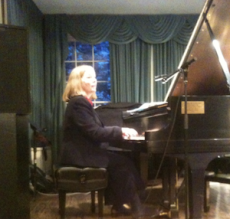
Daily Dose Of Jazz…
Lucy Galliher was born in Washington, D.C. on November 11, 1954. He graduated from Maret High School, received her BA in Music from Oberlin College and received a National Endowment for the Arts grant to study jazz piano with Joanne Brackeen. She went on to study at BMI Jazz Composer’s Workshop with Manny Albam, Roger Kellaway, Jim McNeely and also studied piano with Art Lande, Mark Levine, Barry Harris, and Hansi Alt.
She is on the faculty of Brooklyn-Queens Conservatory of Music and the Greenwich House Music School. She has held the position of East Coast Editor of Jazz Now Magazine, has performed on Broadway, cruise ships, recorded albums, and performed live in a variety of settings.
Pianist Lucy Galliher, who currently is an online Jazz Reviewer, continues to perform and record.
More Posts: bandleader,history,instrumental,jazz,music,piano
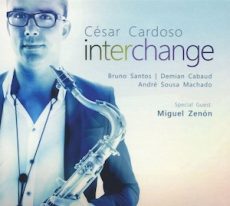
Daily Dose Of Jazz…
César Cardoso was born on November 10, 1982, in Leiria, Portugal. At only seven years old he dedicated his time to studying music, From 2004 to 2008 he studied at Hot Clube de Portugal’s Jazz School, where he had lessons with Jorge Reis and Pedro Moreira and started to distinguish himself as a jazz musician. 2008 had him enrolled at Escola Superior de Música de Lisboa, where he continued to work with Jorge Reis and Pedro Moreira. Completing a Jazz Bachelor Degree in saxophone performance, he became a member of the dixieland group Desbundixie with whom he recorded Kick’n Blow in 2007 and Up 2 Nine in 2009.
In 2010, César recorded his debut, Half Step, with his quintet at that timefollowed with a second album, Bottom Shelf, was released five years later in Hot Clube de Portugal, and features his original music this time written for His third album Interchange, was recorded with special guest, Miguel Zenón on alto saxophone.his quartet. His fourth album, Deice of Tenors, is a large ensemble recording.
He published the book Teoria do Jazz (Jazz Theory), with Chiado Editora, the first book ever written in Portuguese about the theoretical bases of Jazz, thought through to serve as a handbook for jazz students. His second book, a complement of the first, is titled Teoria do Jazz – Exercícios. Cardoso has composed and arranged for big bands, such as the Orquestra Jazz de Leiria and the Orquestra do Hot Clube de Portugal.
Saxophonist César Cardoso has won awards, became the first Portuguese musician to become an Artist Henri Selmer Paris, completed his PhD in Music and Musicology, and continues to perform, compose, arrange and teach at the Universidade de Évora in the Jazz degree program and is the pedagogical director of Escola de Jazz de Leiria.
More Posts: bandleader,history,instrumental,jazz,music,saxophone
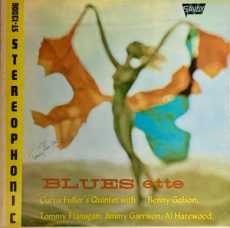
Requisites
Blues-ette ~ Curtis Fuller Quintet | By Eddie Carter
Curtis Fuller is widely regarded as one of the top jazz trombonists. A few nights ago, I enjoyed listening to this morning’s album from the library, and that’s what inspired this discussion of his 1959 release, Blues-ette (Savoy MG-12141/SST-13006). Throughout his more than 65 years in music, Fuller built an impressive catalog of recordings, both as a band leader and as a sideman, including work with Joe Henderson, Lee Morgan, Bud Powell, Wayne Shorter, Jimmy Smith, the Jazz Messengers, and the Jazztet. On this album, he’s joined by fellow Jazztet member Benny Golson on tenor saxophone, Tommy Flanagan on piano, Jimmy Garrison on bass, and Al Harewood on drums. The copy of this album I own is the 1973 U.S. stereo reissue, which shares the original catalog number.
Five Spot After Dark by Benny Golson opens the album. It’s a delightful medium-tempo tune that the front line brings to life with the melody. Curtis begins with a relaxing, welcoming solo. Benny blends each note of the following reading with a joyful energy. Tommy keeps the beat alive in the third interpretation. Jimmy joins the front line for the closing statement, leading to the ending theme and climax. Undecided by Sydney Robin and Charlie Shavers is a catchy tune that opens with the quintet laying down a gorgeous mid-tempo beat on the theme. Fuller takes center stage next with an impressive interpretation. Golson comes right behind him with an irresistible improvisation. Harewood provides a concise, impactful solo alongside both horns, building up to a lively reprise and a satisfying ending.
The title tune, Blues-ette by Curtis Fuller, wraps up the first side with Tommy’s sprightly introduction to the melody’s theme. Curtis sets the mood in the opening statement, delivering an understated and moving narrative. Benny effortlessly rises to the occasion in the following performance. Tommy follows with a dazzling display, then Jimmy caps the solos with a short walk to the ensemble’s close. Benny Golson’s Minor Vamp is anything but, as the second side unfolds, beginning with Garrison and Harewood’s introduction to the lively melody. Golson kicks off the solos, pouring his heart into each note. Fuller gives a captivating performance of lively verses next. Flanagan gets the last word with an energetic solo, ahead of the ensemble’s closing chorus and fadeout.
Love Your Spell Is Everywhere by Edmund Goulding and Elsie Janis begins with the quintet’s medium-tempo theme. Benny takes the lead with an exquisitely crafted performance. Next, Curtis gets into the groove with an exceptional reading that’s cool, smooth, and polished. Tommy executes the closing statement with meticulous execution ahead of the ensemble’s end theme and close. Garrison and Harewood open the door to the quintet’s easygoing unison melody to Curtis Fuller’s Twelve-Inch. Golson takes the stage first with a sweet and tasty reading. Fuller makes his case next with a captivating contribution. Flanagan moves sprightly along in the third solo, and Garrison puts the exclamation point on the song before the quintet comes back together to wrap things up.
“Blues-ette” was supervised by Oscar “Ozzie” Cadena, and Rudy Van Gelder managed the recording controls. The sound quality of this reissue is exemplary. The instruments deliver a vibrant soundstage that places the listener’s sweet spot in the studio with the musicians. If you’re a longtime fan of Curtis Fuller or are just discovering his discography, I invite you to check out “Blues-ette” on your next trip to your favorite record store. It’s a terrific album and is highly recommended for anyone’s library who enjoys hard-bop or lively “blowing sessions.”
~ Love Your Spell Is Everywhere – Source: Wikipedia.org © 2025 by Edward Thomas Carter
More Posts: choice,classic,collectible,collector,history,instrumental,jazz,music,trombone
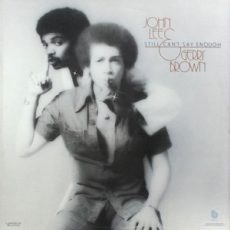
Daily Dose Of Jazz…
Gerry Brown was born on November 9, 1951 in Philadelphia, Pennsylvania. He began playing the drums at the age of five and played with soul groups and played in high school with bassist John Lee, with whom he attended music academy in 1970.
In 1971, he moved to New York City where he played with Lionel Hampton. In 1972 he moved to the Netherlands with Lee to join Chris Hinze’s rock jazz group. They recorded a series of albums in the 1970s. Alongside Lee, he also worked for Jasper van ‘t Hof, Toto Blanke, Charlie Mariano, Eef Albers and Gary Bartz mid-decade. Subsequently, they were members of Larry Coryell’s The Eleventh House for two years; Brown also played for Stanley Clarke and Chick Corea. In 1979, he accompanied Didier Lockwood at the Montreux Jazz Festival.
Settling in Berlin, Germany for some time in 1982 and worked with George Gruntz, with Joachim Kühn, and with Chris Beckers, Herb Geller, Anne Haigis and Kraan until he returned to the United States. As a sideman Gerry has worked with including ones with George Benson, Michał Urbaniak, Urszula Dudziak, Marcus Miller, Lionel Richie, Sonny Fortune, Alphonso Johnson, Roberta Flack, Joe Sample, Tom Harrell, Dave Samuels, and Chuck Loeb, among others.
Drummer Gerry Brown continues to perform and record.
More Posts: drums,history,instrumental,jazz,music
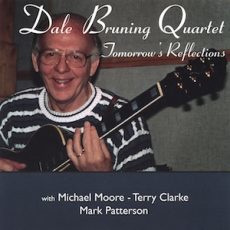
Daily Dose Of Jazz…
Dale Bruning was born on November 8, 1934 in Carbondale, Pennsylvania. During the 1940s and 1950s he spent time living, working and recording in Pennsylvania, New Jersey and New York. During his tenure in the United States Navy from 1953-57, he was a guitarist and arranger, but when called upon he also played piano, bass, vibes, and percussion.
Leaving the military in 1957 he studied at Temple University, graduating with a bachelor of arts degree in psychology. He took as many music classes as he could. Concurrently, he studied music and guitar with Dennis Sandole.
1961 saw him as the leader of the house band for The Del Shields Show, a television variety program. In 1964, he and his family moved to Denver. A broken glass accident in 1988 that deeply cut his wrist nearly ended his performing career. Practicing through the pain during the rehabilitative process was rewarded, and Dale has become an even stronger performer.
Equaled by his talent in composing, arranging and educating, during his 65 plus years of private teaching, he has expressed the joy of jazz to more than 1000 students, and has been featured in numerous magazines.
Guitarist, composer, arranger, author and educator Dale Bruning, who lived in Longmont, Colorado from 1994-2017 and now resides in Thornton, Colorado, continues to perform and record.
More Posts: arrange,compose,guitar,history,instrumental,jazz,music


